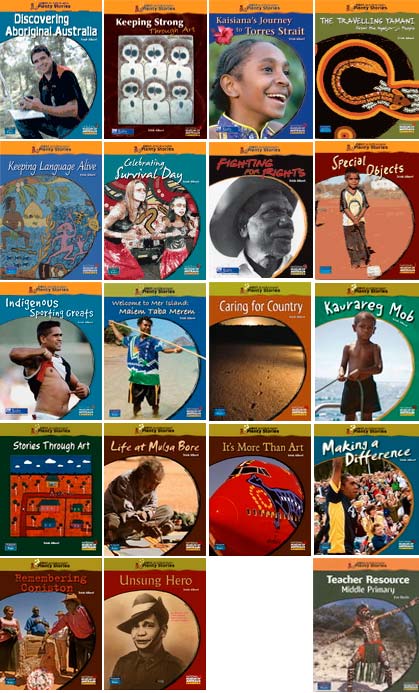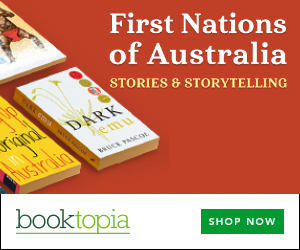Books
First Australians: Plenty Stories
Summary
First Australians: Plenty Stories is a collaboration between the National Museum of Australia and educational book publisher Pearson Australia to provide primary classrooms with a comprehensive resource to successfully implement Australian Indigenous studies.
This resource has been developed to enable teachers to approach the teaching of Indigenous culture and issues with confidence.
The series explores different facets of Aboriginal and Torres Strait Islander life in an accessible and classroom-friendly way.
Key features:
- the series is structured with three connecting themes
- the series draws on a diverse range of sources to tell the stories of significant issues that have faced and are still facing Indigenous Australians
- clearly structured texts include appropriate content and vocabulary support to engage students and maximise learning
- comprehensive teacher support with lessons, activities and blackline masters
- texts are relevant for Indigenous and non-Indigenous students
- aligned with the National Curriculum in Studies of Society and Environment, and State and Territory curricula.
These colourful texts use a range of sources and text types to explore the key themes of the series. Each book features photographs and artwork, many from the National Museum of Australia's collection.

Discovering Aboriginal Australia
What does an archaeologist do? Do you know where the oldest boomerangs have been found in Australia? In this book we discover amazing facts about Australia's human history as we journey through time. We also learn why sites or places are culturally significant and continue to be special to Aboriginal people today.
Keeping Strong Through Art
Art is a very important part of Aboriginal and Torres Strait Islander culture. Through art, traditions are kept alive—traditions tell of people's beliefs, identity and history. This book shows many different types of art including paintings, carvings, costumes, storytelling and dance.
Kaisiana's Journey to Torres Strait
Kaisiana's Journey to Torres Strait explores the travels of one girl who visits her grandmother on Thursday Island. Through Kaisiana's journey, we learn about her cultural identity. This book shows the traditions of Torres Strait Islander people and the importance of place to Indigenous Australians.
The Travelling Yamani: From the Ngadjon-Jii People
In this book, Ngadjon-Jii rainforest people share their beliefs through a creation story about a Rainbow Serpent. We discover an elder's traditional knowledge of bush foods from the rainforest. We also learn about Ngadjon-Jii's continuing connection to special places on their traditional lands of the Atherton Tableland area in North Queensland.
Keeping Language Alive
In 1788 there were 250 Indigenous languages in Australia. About half of them have died out and only 20 Indigenous languages are still strong and spoken by young people. This book shows how three schools are helping to 'keep language strong'. Discover the voices and histories of different Indigenous groups as you learn about the Guugu Yimithirr, Wiradjuri and Torres Strait Creole languages.
Celebrating Survival Day
Different events mark Australia Day on 26 January each year. In 1988 Indigenous Australians and supporters gathered in Sydney to celebrate the survival of their unique cultures, and so Survival Day was born. This book invites us to a Survival Day concert to experience voices of Aboriginal and Torres Strait Islander people as they express their cultures and identities through music and dance.
Fighting for Rights
Today all Australians have equal rights by law, however Indigenous Australians did not always have the same rights as other Australians. This book shows how Aboriginal and Torres Strait Islander people have fought to have their voices heard and to make Australia a fairer place.
Special Objects
Through objects such as tools, jewellery, artworks and toys, traditions of Aboriginal and Torres Strait Islander people are kept alive. Traditions show people's beliefs, identity and history. Objects are special cultural items that can represent voices of ancestors or living persons. In this book we discover five special objects and their makers.
Indigenous Sporting Greats
Sport is an Australian way of life. Through the actions and voices of Indigenous sportsmen and women, we learn about policies and attitudes in Australia towards Indigenous people. This book celebrates their sporting achievements and the contributions they have made to Australian life.
Welcome to Mer Island: Maiem Taba Merem
Meet Joey, a Meriam person from remote Mer Island in the Torres Strait. Learn about Joey's cultural identity and efforts to keep his history alive. What traditions are important to Meriam people and how do they express their connections to their place? Discover why a High Court ruling in 1992 attracted national attention to Mer Island and made Joey's homelands famous.
Caring for Country
Items left behind in the landscape by Aboriginal people tell a fascinating human history stretching back over 60,000 years. Find out why the discoveries of human burials and footprints are of worldwide importance. Explore the cultural heritage of the Willandra Lakes region: a special place for the Paakantji, Ngyiampaa and Mutthi Mutthi peoples, and discover how they 'care for Country' today.
Kaurareg Mob
Meet Joey, a Meriam person from remote Mer Island in the Torres Strait. Learn about Joey's cultural identity and efforts to keep his history alive. What traditions are important to Meriam people and how do they express their connections to their place? Discover why a High Court ruling in 1992 attracted national attention to Mer Island and made Joey's homeland famous.
Our stories Through Art
Art plays an important role in Aboriginal and Torres Strait Islander culture. It is a way for artists to express their histories, cultural identities and opinions, and to share their stories with others. In this book we explore an exciting range of artworks from paintings and sculptures to jewellery and art installations. Discover what has motivated eleven talented artists to create powerful works of art.
Life at Mulga Bore
Meet Lindsay Bird Mpetyane, an Anmatyerr man from Mulga Bore in Central Australia. Follow the making of Lindsay's 'Bush Plum Dreaming' painting, and discover why he paints this special story. Learn how Lindsay and other elders celebrate and teach their Anmatyerr culture to children through activities from painting to finding bush tucker and water 'out bush'.
It's More than Art
How have leading Aboriginal artists, Banduk Marika and John Moriarty, helped others to understand that Aboriginal art is intertwined with culture and identity? Learn how Banduk campaigned for better laws protecting Aboriginal artists and their artworks from exploitation. Through John's life story, we discover his motivation to promote his culture, which led to his company designing the artworks for the Qantas Dreaming planes.
Making a Difference
Many Indigenous Australians strive to educate others about their cultures and promote ideas for reconciliation between Indigenous and non-Indigenous Australians. This book shares inspiring stories about how individuals and organisations have made a difference in Australian society by giving a voice to the histories and viewpoints of Aboriginal and Torres Strait Islander people.
Remembering Coniston
In 1928 in Central Australia, the killing of a European by an Aboriginal man led to expeditions by a police party that resulted in many Aboriginal deaths. These killings are known as the Coniston massacre. How did society view these tragic events? Did Aboriginal people have a voice in 1928? Seventy-five years on, the groups affected share their experiences at a special commemoration for the Coniston massacre.
Unsung Hero
Today all Australians have equal rights by law. However, Indigenous Australians did not always have the same rights including a voice in society, as other Australians. Despite generations of unfair treatment, they have made significant contributions to Australian society and identity. Learn how laws and attitudes impacted on an Aboriginal individual, Eddie Albert. Discover events in Eddie's life including his service in the Second World War.
Get a copy now from your favourite trusted store
Disclosure: I get commissions for purchases made through the below links.
